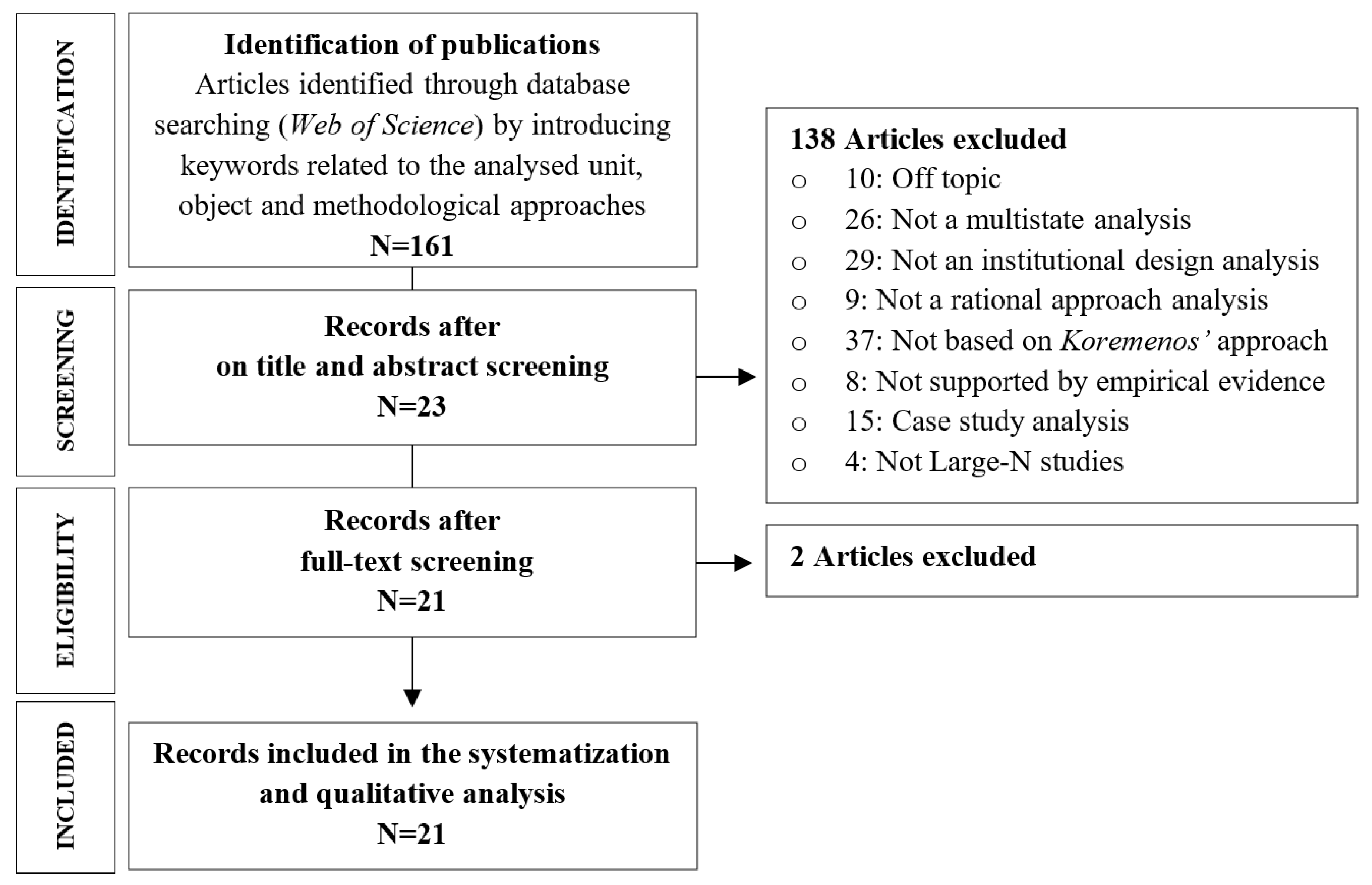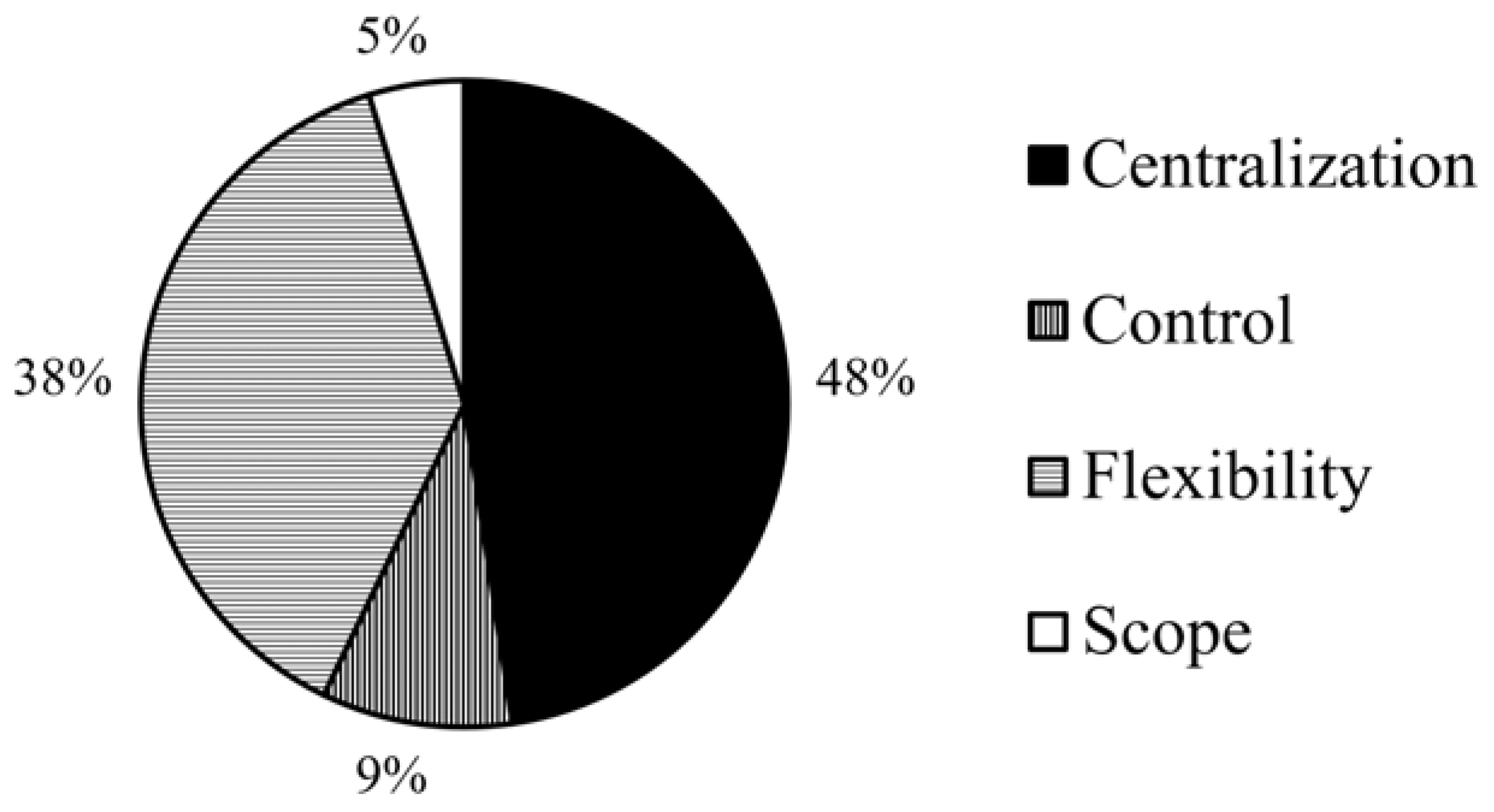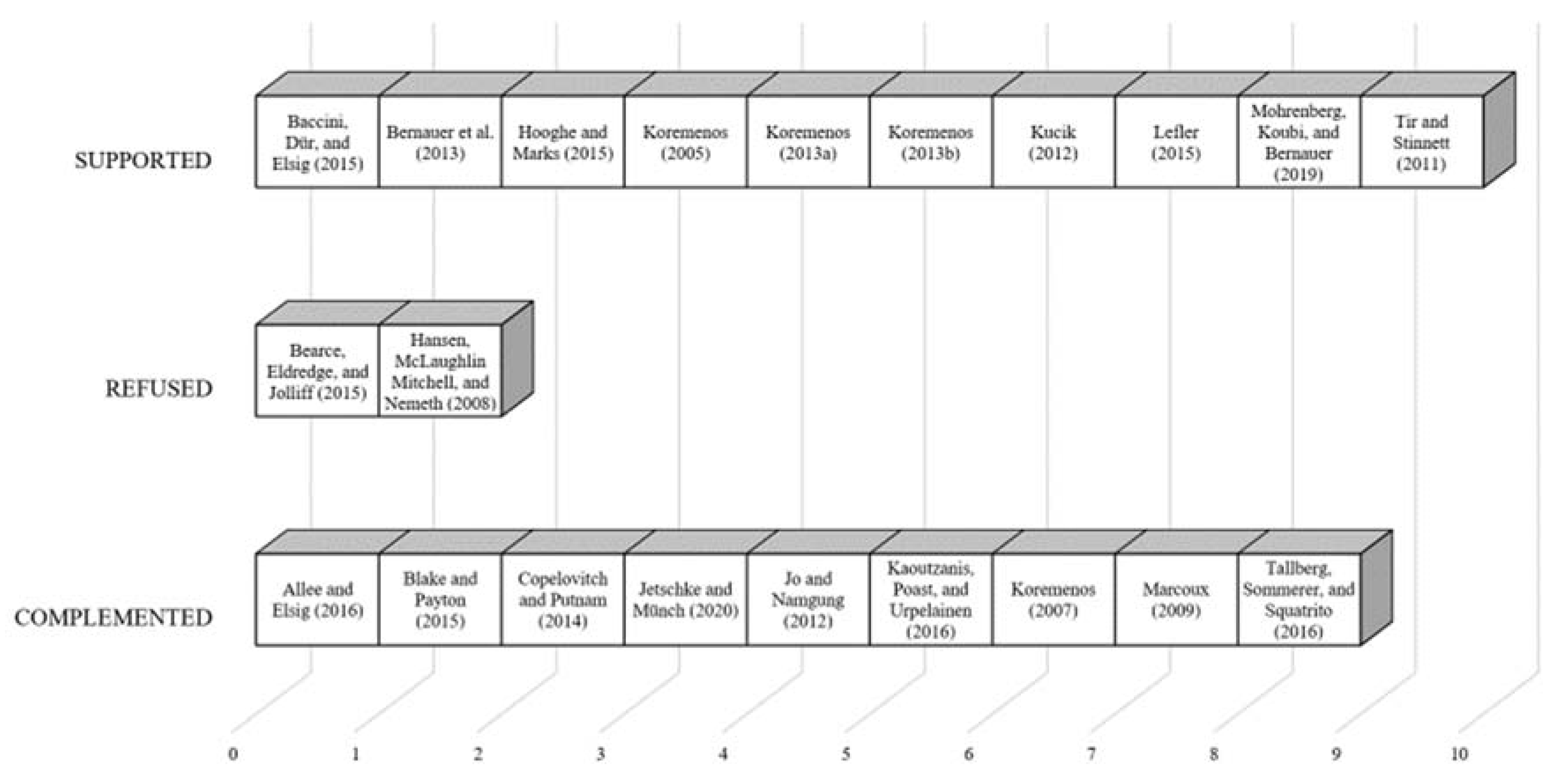4.3.1. The Authors’ Approaches to the Rational Project
Initially, the literature was divided between the causes and consequences research lens. While 15 out of 21 dived into the nature of institutional design, 6 contributions [
75,
76,
77,
79,
88,
89] query about its implications. Secondly, a systematization was employed to identify the specific variables analyzed within the Koremenos, Lipson, and Snidal [
2] framework. However, some articles addressed the rational project without specifying a variable or conjecture [
62,
82,
89]. Other contributions aimed to address the complete logic of the rational design proposition [
84,
85]. These records constituted 23.81% of the sampled literature. The remaining records that included specific variables in their investigations represented 76.19% of the sample.
Although the authors within this second group could explore dependent or independent variables, the systematization revealed that all of them focused on dependent variables. In other words, when these authors performed quantitative research on the rational design of institutions, they were interested in specific design features. In fact, 6 out of the 16 authors in this group concentrated only on institutional characteristics. On the other hand, cooperation problems are never studied in isolation. In the remaining 10 studies, they were addressed along with dependent variables. The frequency with which the institutional design features and cooperation problems were addressed is depicted in
Figure 3 and
Figure 4. Such frequency incorporates the causes vs. consequences distinction.
In addition to these figures,
Table 7 summarizes the way in which each author has dealt with the rational approach. The implications of the identified patterns are outlined in the following section. Within
Table 7, a column has been placed to summarize the conjectures with which the authors deal, if any. Sometimes this inclusion was clearly expressed by the articles. In other occasions, articles hypotheses were related to rational design conjectures, but they did not mention them explicitly. Finally, some studies analysed variables without referring to rational project conjectures.
Regarding dependent variables, the systematization revealed a clear preference towards CENTRALIZATION and FLEXIBILITY. All of the corresponding conjectures were included in the quantitative research studies. In other words, the scholars who analysed the rational design of international institutions mainly focused on these two institutional features. The literature identified the concept of CENTRALIZATION in the context of the establishment of dispute settlement mechanisms and FLEXIBILITY in the context of the existence of escape and renegotiation clauses. Both of these design features are linked to the normal progress and development of an international institution once it has been established. Consequently, their prominence highlights how rationalism may hold higher explanatory power regarding how institutions develop and evolve.
The remaining dependent variables proposed by Koremenos, Lipson, and Snidal [
2] received considerably less attention. The examined scholarship linked CONTROL with specific voting rules and SCOPE with the spectrum of issues addressed by institutions. This omission is consistent with the fact that both of these factors involve decisions traditionally addressed when institutions are founded. The same is the case with MEMBERSHIP, which is unrepresented in research studies and constitutes a gap in the literature.
Regarding independent variables, UNCERTAINTY arose as the most frequently observed cooperation problem, followed by NUMBER. This observation is consistent with the predominant dependent variables and with rational logic. After all, institutions resolve adverse circumstances such as information asymmetries and uncertainties within inherently hostile environments to facilitate cooperation [
85]. The other two examined difficulties received less attention. ENFORCEMENT only appeared in two records, and DISTRIBUTION was not mentioned in the quantitative studies. Considering that the literature has identified compliance with commitments as one of the recurrent problems of institutionalized cooperation [
91], these trends reveal deficiencies in the rational design project and indicate future lines of research.
To facilitate a search for transversal patterns,
Table 8 shows which variables were analyzed in each category of international institutions. The examined empirical studies prioritized FLEXIBILITY when analyzing agreements and CENTRALIZATION when studying organizations. The agreement research focused on procedures used to adapt to new circumstances, and the organization research focused on individual organizations’ formalization levels or their performance of important tasks. This finding is consistent with the nature of these organizations as international institutions. The same pattern is applicable to the examined cooperation problems. The authors examined UNCERTAINTY when observing the design of agreements and NUMBER when considering an organization’s design.
4.3.2. Rationalism Contestation
Thus far, the relevance of the rational design of international institutions has been verified. The findings of this study on units of analysis and methodological approaches have shown the need for a complementary dialogue between traditions. Furthermore, the initial observation made regarding the studies’ objects of analysis has revealed the existence of concrete rational research patterns supporting this suggestion. Accordingly, it should now be determined how these studies support rational statements. In doing so, this research aims to clarify the extent of the explanatory power of rationalism. The previous systematization categorized the examined articles according to their implications for rational design projects. These implications could support or complement Koremenos, Lipson, and Snidal’s [
2] approach.
As observed in
Figure 5, the main group of the articles (10 out of 21) supports rationalism with empirical evidence. Remarkably, three of them are authored by Koremenos. Initially, this research suggests that Koremenos, Lipson, and Snidal’s [
2] statements are strongly supported by the empirical literature. The support of the second subgroup (11 out of 21) of studies is ambiguous, and the rational explanations of these studies are complemented by other potential variables. Noticeably, this trend supports the belief that institutionalism schools should meet halfway.
Aiming to offer depth in terms of the implications of these results,
Table 9 categorizes the research outcomes according to the specific variables that each study examines. As shown, the quantitative research studies on the rational design of institutions strongly support conjectures related to certain variables such as CENTRALIZATION and FLEXIBILITY. However, even these are complemented with other explanatory variables. In the same line, research reveals how rationalism alone particularly struggles to explain how international institutions define their SCOPE and CONTROL features. Regarding cooperation problems, rationalism offers sound explanations for how decision-makers deal with UNCERTAINTY. However, other logics, such as constructivism or realism, complement rational schools of thought on how actors address ENFORCEMENT and NUMBER problems.
Regarding CENTRALIZATION, the rational conjectures are mostly complemented by other approaches such as diffusion literature. Thus, several articles argue against Koremenos, Lipson, and Snidal’s [
2] proposition even though their statements are verified. The earliest empirical research on CENTRALIZATION was developed by Koremenos [
83]. This work discusses how cooperation problems such as UNCERTAINTY and ENFORCEMENT influence institutional CENTRALIZATION. Inspired by Goldstein et al. [
51], Koremenos [
84] includes COMMITMENT and the prisoners’ dilemma-like incentives as cooperation as cooperation problems in this work. Remarkably, the inclusion of COMMITMENT represents an attempt to incorporate growing concerns within the International Law discipline into the rational project. As a result, it reconciles the International Relations and International Law bodies of literature on the concept of compliance, which is a dichotomy overviewed in previous works [
91].
This new independent variable, which is conceptually close to ENFORCEMENT, is based on the understanding that rational actors use international legalization to constrain present and future domestic behavior. This use of international legalization is identified as increased centralization or the integration of delegated dispute settlement resolution procedures. Bélanger and Fontaine-Skronski’s [
52] (p. 258) empirical research on the concept of legalization supports this identification. Their work identifies three dimensions that constitute legalization: obligation, precision, and delegation. The latter dimension is related to the centralization feature of rational authors.
Consequently, Koremenos [
83] represents a considerable advancement in the context of the CENTRALIZATION issue. Statistical patterns show that the decision to include dispute resolution within the governance structure of an international agreement is induced by a cost (delegation entitles sovereignty lost) and benefit (challenging cooperation problems) analysis. In other words, empirically, actors opt for high levels of centralization or legalization when they face UNCERTAINTY, ENFORCEMENT, and COMMITMENT problems. In line with this logic, Tir and Stinnett [
90] determine that highly contentious issues have a greater effect on the institutional design of river treaties than contextual and power politics factors. They verify that implementation and compliance difficulties, such as UNCERTAINTY or ENFORCEMENT problems, are associated with high levels of INSTITUTIONALIZATION or the inclusion of provisions for institutional governance (centralization). In doing so, they support rational problem-solving logic and Bernauer et al.’s [
76] statement that environmental problem structures are a key determinant of institutional design.
Tir and Stinnett [
90], Jo and Namgung [
81], Hansen, McLaughlin Mitchell, and Nemeth [
79] and Lefler [
87] conduct studies that deal with CENTRALIZATION. All of these researchers vaguely explore Koremenos, Lipson, and Snidal’s [
2] conjectures, but their conclusions inherently contribute to the examined debate. First, Jo and Namgung’s [
81] (p. 1061) research on preferential trade agreements reveals that both macro- and micro-level factors explain the inclusion of dispute settlement mechanisms. The micro-level incentives introduced by the rational design project are complemented by the macro-level trends within the literature on diffusion. Remarkably, their findings support legalization theses [
3] by which the delegation of dispute settlement functions is subject to domestic politics as well as international political conditions. In their work, they note a crucial constructivist concern. They show that previous legal frameworks have an influence on subsequent institution creation, especially in the context of dispute settlement mechanism design in trade agreements. This emulation process occurs through comembership and is explained by the fact that decision makers are usually “trade bureaucrats” who participate in subsequent trade negotiations. This finding supports the belief that institutional designs are not only the result of problem-solving procedures; indeed, other explanatory variables, such as existing legal frameworks, also contribute to their creation.
Hansen, McLaughlin Mitchell, and Nemeth [
79] (p. 300) also underline the role of executive and highly centralized bureaucratic branches in the promotion of dispute resolution. Their research addresses the role of international organizations as problem-solving structures. They connect their success as conflict managers to institutionalization (CENTRALIZATION), member preference similarities (a concept that reminds them of the distribution cooperation problem), and democratic member history. Their proposition applies rational design logic, according to which institutions are problem-solving structures. Such research, placed within the consequences approach, concludes with the need to include contingent factors such as preferences and domestic regimes when analyzing IO efficacy. Finally, Lefler’s [
87] (p. 93) analysis of international organizations focuses on diverse approaches to dispute resolution based on control, transparency, and elements of distributional bias. It examines why states strategically select mediation or arbitration for conflict management. It can be determined that this research supports rational logic, as it concludes that forum selection for dispute resolution is related to settlement compliance.
Instead of reviewing only CENTRALIZATION problems, Bernauer et al. [
76], Copelovitch and Putnam [
78], and Allee and Elsig [
74] additionally analyze the issue of FLEXIBILITY. The first study supports a rational approach, while the other two complement it. The research of Bernauer et al. [
76], based on the presumption that states are rational actors, proves the inconsistency of the depth versus participation dilemma in the context of global environmental cooperation. Copelovitch and Putnam’s [
78] research is similar since they take duration, dispute settlement clauses, and exit clauses into consideration. However, they discuss the explanatory power of deductive and rational design theories, claiming that strategic behavior should be examined in conjunction with the decision environments where such behavior occurs. As stated in this study, the institutional context jeopardizes the explanatory power of uncertainty because prior institutional and legal commitments also shape states’ choices on agreement design. Notably, this statement is in line with the findings previously underlined. Similarly, Allee and Elsig’s [
74] (p. 116) research on international agreements concludes that their investigation “reconciles divergent perspectives on institutional design, showing that international agreements can reflect not only rational design but also the unique needs and preferences of states and regional actors”.
On the subject of FLEXIBILITY, this research observes both supportive voices [
2,
64,
86] and enlightening debates. For instance, Marcoux’s [
88] (p. 225) research on multilateral environmental agreements (MEAs) complements the rational approach. This study adds power asymmetry explanations to rational statements on flexibility provisions. Notably, this implies that, empirically, realist statements could also be incorporated into the design of international institutions. Bearce, Eldredge, and Jolliff [
75] also complement the FLEXIBILITY proposition but with a consequential approach. By alternatively treating this feature as an independent variable, they show its impact on negotiation length.
CENTRALIZATION has also been studied in conjunction with CONTROL. Hooghe and Marks [
63] (p. 307) connect these variables with the concepts of delegation and pooling, which are two dimensions of authority in international organizations. Thanks to authority, organizations can deal with problems associated with many members and large organizational scopes because it reduces transaction costs and centralizes decision-making procedures. These results support rational conjectures, showing that large membership groups (NUMBER) are positively related to CENTRALIZATION and CONTROL. Additionally, this research points out that Hooghe and Marks [
63] (p. 311) partially argue in support of Koremenos, Lipson, and Snidal’s [
2] proposition since SCOPE, a dependent institutional feature, is identified as a driving factor of authority. Similarly, Jetschke and Münch [
80] state that functionalist mechanisms are more consistent than domestic regimes in terms of conducting delegation procedures by which parliaments and courts are created. In other words, these mechanisms are initially created to monitor the compliance of member states, and eventually they may become institutions of democratic control. This research finds that the democratization literature adopts a particularly strong confrontational perspective on rational design, especially regarding its CONTROL features.
Additional quantitative research on CONTROL, such as that of Blake and Payton [
77], found that the voting rules of states are explained by the design objectives that they prioritize: control, effective membership, compliance, or responsiveness. According to rational logic, when the NUMBER or membership is large, states avoid establishing unanimity voting rules (less CONTROL) to ensure responsiveness. On the other hand, they choose to implement unanimity rules (greater CONTROL) when their core interests are at stake and implement weighted voting to retain the major powers central to their institutions’ effectiveness.
Once the ways in which authors address rational variables have been examined, the articles that focus on RATIONAL LOGIC as a whole should be observed closely. Koremenos [
84,
85] introduced the COIL database and researched the inclusion of punishment provisions that support rational design. The theoretical reflection of Koremenos [
84,
85] links cooperation problems such as enforcement, uncertainty, number, and commitment with the design of punishment provisions. These provisions may vary in terms of formality or flexibility depending on the heterogeneity and power asymmetry that involved parties must address. This connection between flexibility and distribution problems involving power is also outlined by Marcoux [
88]. In line with Marcoux [
88], Mohrenberg, Koubi, and Bernauer [
89] investigate the design of multilateral environmental agreements. This research offers empirical support to the problem-solving structures of international institutions that underline rationalism.
On the other hand, the research studies of Kaoutzanis, Poast, and Urpelainen [
82] and Tallberg, Sommerer, and Squatrito [
62] address rationalism in the context of the IO democratization literature. Kaoutzanis, Poast, and Urpelainen [
82] examine rational logic in the context of the design of institutions but emphasize the role of domestic regimes in how states overcome cooperation problems. Tallberg, Sommerer, and Squatrito [
62] go one step further. According to their research, dominant approaches such as rational functionalism and sociological institutionalism should be complemented by a third factor: regime type. In other words, cooperation problems (Koremenos, Lipson, and Snidal [
2]), organizational culture (Barnett and Finnemore [
22]), and domestic political systems together explain the design of international institutions.















